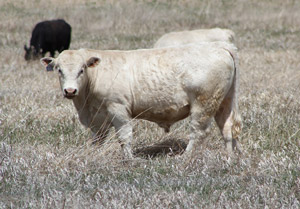How Many Clean-up Bulls Are Needed After Estrus Synchronization and AI?
March 2016

The following article is a summary of the article reviewing scientific literature evaluating bull:female ratios following estrus synchronization and artificial insemination (AI) found in the 2016 Nebraska Beef Cattle Report.
One of the benefits of estrus synchronization and AI is purchasing and maintaining fewer bulls. However, an idea has been circulating that synchronized females not becoming pregnant to AI will return to estrus at the same time and require the same number of bulls as natural service without AI.
Research has indicated cows not conceiving to AI will return to estrus over a 12d period following a single timed AI. The most active day had 18 percent of the herd in estrus, with the remainder of the distribution a bell curve (Figure 1 below). Each cow’s estrous cycle is slightly different. Some cows have 2 follicular waves during the estrous cycle, while others have 3. This results in a natural variation in cycle length, causing the non-pregnant cows’ return to estrus to vary.
There will be three or four days when many of the non-pregnant females will be in estrus. On those days it is important to increase observation of bulls, especially in large or multi-windmill pastures, to ensure they are all sound and working.
No effect of bull to female ratio or number of females expressing estrus per bull on pregnancy rate was found when comparing bull to heifer ratios ranging from 1:7 to 1:51 in heifers synchronized with Synchro-Mate B. In a comparison of bull to heifer ratios ranging from 1:16 to 1:50 in herds of 100 heifers synchronized with melengestrol acetate (MGA)-PG and immediately exposed to bulls, the optimal bull to heifer ratio for synchronized heifers was 1:25 based on both biological and economic criteria. If the optimal bull to heifer ratio in a synchronized natural service setting is 1:25, it can be extrapolated with a hypothetical AI pregnancy rate of 50 percent, the number of clean- up bulls needed is decreased by 50 percent.
Data was summarized from published studies reporting AI and final pregnancy rates, and bull to female ratio. Of the data collected, studies were divided into bull to female ratio groups including Normal-Natural Service (NS, 1:20 to 30 bull to female ratio), and 3 groups following estrus synchronization and AI:
- normal (NORM, 1:20 to 30),
- intermediate (INT, 1:31 to 49), and
- half (HALF, 1:50 to 60).
The final pregnancy rate of a normal bull to heifer ratio in a natural service setting was 87.8 percent. Final pregnancy rate in the NORM was 87.7 percent. The final pregnancy rate in the INT group was 82.6 percent and the final pregnancy rate of the HALF was 89.2 percent. Bulls turned in at half the normal bull to female ratio following estrus synchronization and AI resulted in final pregnancy rates similar to normal bull to female ratio both in a natural service situation and following estrus synchronization and AI.
A consideration to make prior to choosing a bull to female ratio is bull age. Experienced bulls are more efficient breeders, while yearling bulls are less experienced.
Another consideration is pasture size and terrain; a rugged, multi-windmill pasture may demand more from a bull than a flat single-windmill pasture.
Conclusion
In conclusion, producers utilizing estrus synchronization and AI should keep in mind the similarity between final pregnancy rates when using a 1:25 bull to female ratio and 1:50 bull to female ratio. Producers need to evaluate the cost difference of purchasing and maintaining twice as many bulls to maintain a 1:25 bull to female ratio following estrus synchronization and AI.
Rick Funston, reproductive physiologist, purchases 100 heifer calves every fall for the West Central Research and Extension Center and AI in the spring. He has never used more than half the normal number of bulls that is recommended without AI and has consistently reported over 90 percent final pregnancy rates in a 60d clean-up breeding season. This includes more than 1,200 heifers to date.
Producers interested in synchronization protocols and reproductive management resources can access them on the Beef Reproduction Task Force Resources page.
Full report: How Many Clean-up Bulls Are Needed After Estrus Synchronization and AI?
Hazy Nielson
Nielson Reproductive Service, Ellsworth, NE
Rick Funston, Ph.D.
Reproductive Physiologist
West Central Research and Extension Center, University of Nebraska